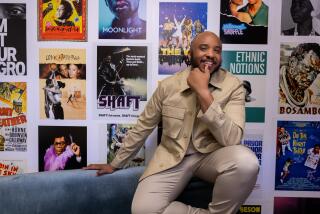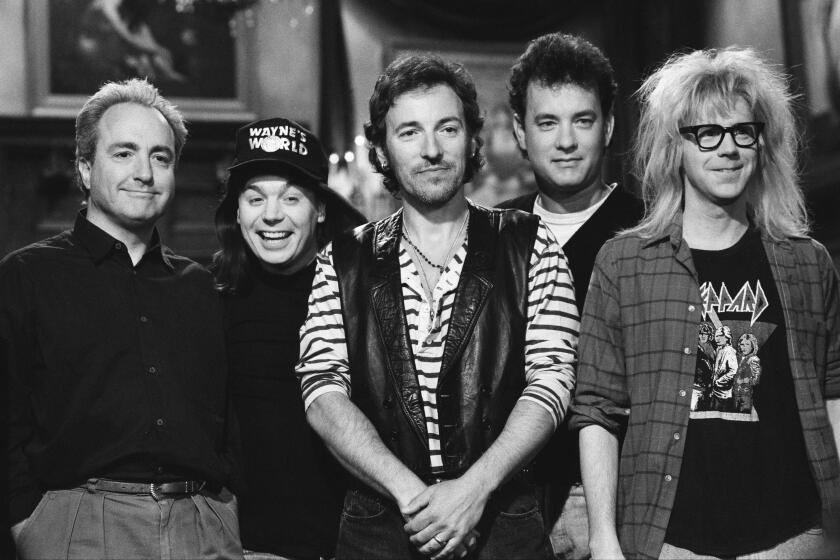Preserving Hollywood’s History
- Share via
Buddy Ebsen chuckled when interviewer Daryl Anderson asked him for a Louis B. Mayer story. Ebsen, 90, then acknowledged that “I burned my bridges” with the legendary MGM studio boss as a young man by refusing to sign a long-term contract binding him to the studio.
“I told him I didn’t want to be a piece of goods on his counter,” Ebsen told Anderson during a recent taped interview for the Screen Actors Guild Foundation’s Legacy Documentation program. “They kept me for two more years, until I got sick doing ‘The Wizard of Oz.’ After that, I ended up going back to vaudeville for a fraction of the money and freezing up in the Poconos. But I’m glad I did it.”
“People like Ebsen go back to where it all began,” said Anderson, who played the news photographer known as Animal on the TV series “Lou Grant.” “They were part of something special, and we need to capture that while we still can.”
Ebsen’s trip down memory lane was recorded for posterity in July. His is one of 11 interviews conducted by Anderson or fellow actor Paul Napier with aging stars taped in the last year by a crew of current and former USC students. They were working under the direction of Amanda Pope, a tenured film professor at USC, for the revitalized Legacy program.
The SAG Foundation, the guild’s charitable/educational adjunct, began the project in 1989 to create a video archive of the guild’s history. (Ebsen’s interview was audio only as he declined to appear on camera, but all others have been videotaped.)
Between 1989 and 1994, 15 interviews were done, 12 filmed by Oscar-winning documentary filmmaker Terry Sanders (“Maya Lin: A Strong Clear Vision”). Funding problems, however, slowed the program from 1991 until last year, when Marcia Smith, the foundation’s executive director, arranged for the USC School of Cinema-Television to take over filming and producing the interviews at a fraction of the cost of the earlier interviews.
The Legacy program is not the only one of its kind in Hollywood. The Directors Guild has long published books taken from audio interviews with important members, and the Writers Guild Foundation has done 14 videotaped interviews in the last three years, although none this year, with selected writers.
Among others who are either doing or have done oral histories are the Academy of Motion Picture Arts and Sciences, Directors Guild of America, Writers Guild of America, Syracuse University, the American Film Institute and the Archive of American Television (see accompanying story, Page F1).
Those involved in the SAG effort plan to conduct a minimum of one interview a month, continuing indefinitely.
“The program had taken on a sense of urgency as we were losing more people all the time,” Smith said. “Before, they were using a wonderful, award-winning filmmaker, but we needed to find a way to do it so that we could afford to do more than one or two a year. So we approached the local film schools about creating a whole new program. USC responded positively, and we made an arrangement with them.”
Although interviews thus far have focused on former SAG presidents, board members and employees, as well as others who played important roles in Hollywood’s labor fight, a viewing of the existing tapes makes it clear that the union’s history is inseparable from the larger history of Hollywood itself.
The union’s secret 1933 birth is covered, as is the guild’s fight to keep out mobsters. Actor John Randolph passionately explains what it was like to be on the blacklist of the 1950s, and Cliff Robertson offers possibly his most detailed remarks to date about the infamous David Begelman scandal of the late 1970s, when he blew the whistle on studio corruption.
Ed Asner’s tape details his stormy tenure as guild president and his battles with Charlton Heston. Howard Keel, another former SAG president, explains events leading to the union’s still controversial decision to give up residual rights to films made before 1958 in return for money that seeded the union’s health and pension fund. James Garner, a two-time Purple Heart recipient in the Korean War, says his 18 major operations have made him “most grateful” for the union’s medical benefits plan.
Ebsen reminisces about spending time with Eddie Cantor and corrects the famous story that he had to drop out of “The Wizard of Oz” because he was allergic to the metallic paint used to turn him into the Tin Man: “I breathed in [the suit’s aluminum dust] and became ill,” he tells his interviewer. “I had to be hospitalized for over four weeks.”
The recent death of Red Skelton brings home the program’s importance, according to Timothy Blake, chairwoman of the Foundation’s Legacy Committee. “We had scheduled Red Skelton to be interviewed this month, and then he died before we could do it,” she said. “Jimmy Stewart and Robert Mitchum were also on our list.”
In recent weeks, Pope’s crews have taped chats with Keel, Garner, Robertson, Ebsen, Ricardo Montalban and Dennis Weaver, among others. Confirmed for future tapings are Jack Lemmon, Anthony Quinn, Jane Powell and Karl Malden. Smith says Olivia de Havilland, now 81 and residing in Paris, has also agreed to participate once she finishes writing her autobiography. (De Havilland played a major role in Hollywood’s labor history by successfully suing Warner Bros. in the 1940s to limit the ability of studios to control actors by tying them up with lengthy contracts.)
Interviewees have been unusually forthcoming, Napier and Anderson say. “I have yet to have them duck a single question,” Napier said. And there are no limits on what participants may talk about, nor is there any attempt to sugarcoat history. Randolph, for example, sat for one of the early interviews--in 1990 with Sanders--and he pointed out that the union leadership of the 1950s never fought the blacklist.
“I was worried they wouldn’t let me talk about certain things,” said Randolph, now 82, and one of the actors honored during the recent industry commemoration of the blacklist. “After all, some of the union history isn’t very pretty. I remember getting a letter from the union board, for example, telling me to cooperate with government investigators or else. It was difficult to talk about some of that stuff, but it was important that I provide the material so they can have a proper history.”
Robertson’s interview details how he and his family received anonymous threats in the wake of the Begelman affair and how they had to keep their movements secret for months. It’s his view such history must be recorded, warts and all.
“We should never be afraid to examine ourselves, our industry, our union and our art,” Robertson told The Times. “There has always been fear in Hollywood of standing up for what is right and not being intimidated. That’s part of our history. The union started by having to fight studio bosses and gangsters, if you recall. There was the whole blacklisting era and what happened to me and many others. Recording the history is one way of making sure people can learn the truth.”
*
* Requests for access to the Legacy Documentation program tapes can be made to Marcia Smith at the Screen Actors Guild Foundation, (213) 549-6708.
More to Read
The biggest entertainment stories
Get our big stories about Hollywood, film, television, music, arts, culture and more right in your inbox as soon as they publish.
You may occasionally receive promotional content from the Los Angeles Times.










